|
|
The Soviet Barbarossa Surprise!
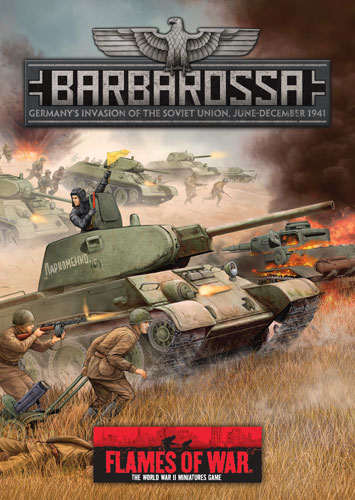 |
The Soviet Barbarossa Surprise!
The Introduction Of The T-34 and KV
with Wayne Turner
In 1941, the Germans and their various allies invaded the Soviet Union and generally had the upper hand in the early months of the fighting. However, on occasion they would run into some tanks that were surprisingly resistant to their tank weapons. What could stop the seemingly unstoppable German Wehrmacht war machine? The answer was two new designs, the T-34 medium tank and the KV heavy tank.
The T-34 resulted from a project started at the
Khakov tank factory under a project to build a better protected fast
tank for use with mechanised forces. The prototypes abandoned the track
and wheeled concept of the BT tanks and went for a purely tracked
design. The Prototype A-32 design used a 76.2mm L-11 gun, a longer and
more powerful weapon than the one used in the T-28. The first model of
T-34, the T-34 obr 1940, was put into production and distributed to the
mechanised corps in 1940.
|
| In 1938, as part of the review of the current
heavy tanks design, a number of new tanks designs were put on the table
to consideration. Among these were some new multiple turret designs to
replace the T-35 heavy tank. Two of these were the T-100 and the SMK,
both armed with one 76.2mm gun armed turret and a single 45mm gun armed
turret. The multiple turret had begun to fall out of favour for a more
compact design sporting a high-performance gun in a single well-armoured
turret. The tank designers took much of the hull and track design from
the SMK prototype and a new heavy tank design was created with just a
single turret armed with a 76.2mm gun. The design was put together at
the Kirov Works in Leningrad and named the KV (Kliment Voroshilov, after
the Marshal of the Soviet Union and People’s Commissar for Defence).
All three designs were tested in in combat during the 1939 Winter War in
Finland. The single-turret KV design proved the superior model. The
first model was the KV-1 obr 1939 armed with a 76.2mm L-11 gun. |
T-34 obr 1940
Crew: 4 men. Weight: 26.3 tons. Main Armament: 1x 76.2mm L-11 (1939 model) tank gun. Secondary Armament: 2x 7.62mm DT machine-guns. Ammunition: 76x 76.2mm rounds, up to 4725x 7.62mm rounds. Hull Armour: Front: 45mm, Sides: 45mm, Rear: 40mm, Top: 15-20mm, Bottom: 15-20mm.Turret Armour: Front: 45mm, Sides: 45mm, Rear: 45mm, Top: 16mm. Engine: V-12 W-2/34 Diesel, 500 hp at 1800 rpm. Length: 5920mm, Width: 3000mm, Height: 2400mm. Ground clearance: 400mm. Top Speed: 53 kph, Range: 400 km. |
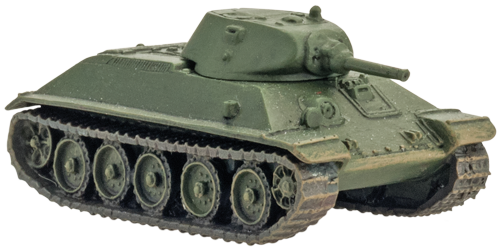 |
The T-34 obr 1940 in Flames Of War
|
| |
|
|
Armour
|
|
|
| Name |
Mobility
|
Front
|
Side
|
Top
|
Equipment and Notes
|
Weapon
|
Range
|
ROF
|
Anti-tank
|
Firepower
|
|
T-34 obr 1940
|
Standard Tank
|
6
|
5
|
1
|
Co-ax MG, Hull MG, Fast tank,
Limited vision, Unreliable, Wide-track.
|
76mm L-11 gun
|
24"/60cm
|
2
|
8
|
3+
|
|
|
A second model, mounting 152mm howitzer in a much
larger turret, was introduced in 1940. It was designate the KV-2 obr
1940. In the tradition of previous artillery tanks such as the BT-7A,
its role was to destroy or supress enemy anti-tank positions. Both KV
tanks were put into service in support of the tanks of the mechanised
corps.
The T-34 and KV tanks had good armour, powerful guns, and
wide-tracks with low ground pressure for better cross-country mobility. |
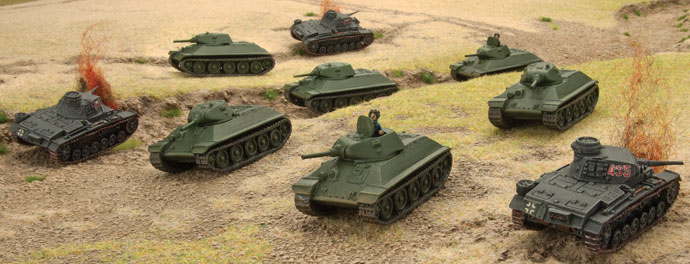 |
The two new Soviet tanks were first encountered
by the Germans on the second day of the invasion. The strength of the
new tank’s armour of both the T-34 and KV took the Germans by surprise,
despite the capture of one of the test KV tanks by the Finns in 1939. In
early encounters, the Germans poured shots into the advancing tanks
with little or no effect. The new tanks just seems invulnerable to the
anti-tank rounds of the 3.7cm and 5cm guns of the Panzer III tanks. One
German report described an
encounter:
“Half a dozen
anti-tank guns fire shells at him [T-34], which sound like a drumroll.
But he drives staunchly through our line like an impregnable prehistoric
monster... It is remarkable that Lieutenant Steup’s tank made hits on a
T-34, once at about 20 meters and four times at 50 meters, with
Panzergranate 40 (5cm calibre), without any noticeable effect.”
(from On Flexibility, by Meir Finkel)
|
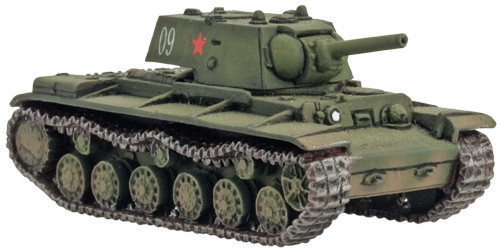 |
KV-1 obr 1040
Crew: 5 men. Weight: 43.5 tons. Main Armament: 1x 76.2mm ZIS-5 or F-34 tank gun. Secondary Armament: 3x 7.62mm DT machine-guns. Ammunition: 111-114x 76.2mm rounds, up to 3024x 7.62mm rounds. Hull Armour: Front: 75mm, Sides: 75mm, Rear: 60-75mm, Top: 30-40mm, Bottom: 30-40mm. Turret Armour: Front: 90mm, Sides: 75mm, Rear: 75mm, Top: 35mm. Engine: V-12 W-2-K Diesel, 600 hp at 2000 rpm. Length: 6750mm, Width: 3320mm, Height: 2710mm. Ground clearance: 450mm. Top Speed: 35 kph, Range: 335 km.
|
| The KV-1 obr 1940 in Flames Of War |
| |
|
|
Armour
|
|
|
| Name |
Mobility
|
Front
|
Side
|
Top
|
Equipment and Notes
|
Weapon
|
Range
|
ROF
|
Anti-tank
|
Firepower
|
|
KV-1 obr 1940
|
Slow Tank
|
8
|
7
|
2
|
Co-ax MG, Hull MG,
Turret-rear MG,
Limited vision, Unreliable. |
76mm F-34 gun
|
32"/80cm
|
2
|
9
|
3+
|
|
|
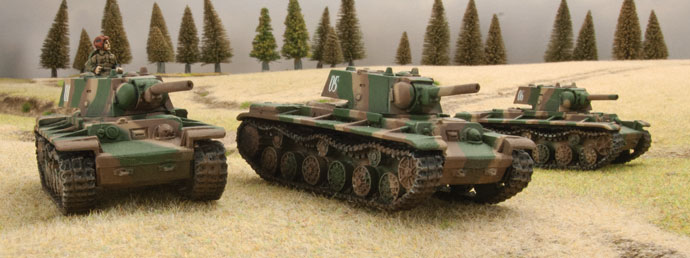 |
|
Another German commander was shocked when he
inspected an abandoned T-34 obr 1940. He had been told nothing by his
superiors of the existence of this imposing vehicle whose armour,
armament, and mobility were all superior to those of any German tank.
It
was during Battle of Raseiniai (Lithuania) that the Germans encountered
the KV heavy tank for the first time. The Soviet 2nd Tank Division (3rd
Mechanised Corps) attacked and overran elements of the German 6.
Panzerdivision near Skaudvilė on 23 June 1941. Unfortunately the Germans
were equipped with the lightly armed Czech Panzer 35(t) tanks, and they
and the division’s anti-tank weapons proved ineffective against the KV
heavy tanks. Even with some of the KVs out of ammunition, the Soviet
heavy tanks were able to close with and destroy a German anti-tank gun
unit by driving over them and crushing them with their tracks. An
account of the same battle from 1. Panzerdivision:
“The KV-1 and KV-2, which we first met here, were really something! Our companies opened fire at about
800
yards, but [they] remained ineffective. We moved closer and closer to
the enemy, who for his part continued to approach us unconcerned. Very
soon we were facing each other at 50 to 100 yards. A fantastic exchange
of fire took place without any visible German success. The Russian tanks
continued to advance, and all armour-piercing shells simply bounced off
them. Thus we were presently faced with the alarming situation of the
Russian tanks driving through the ranks of 1st Panzer Regiment towards
our own infantry and our hinterland. Our Panzer Regiment therefore about
turned and rumbled back with the KV-1s and KV-2s roughly in line with
them.”
(from Hitler Moves East, by Paul Carrell)
|
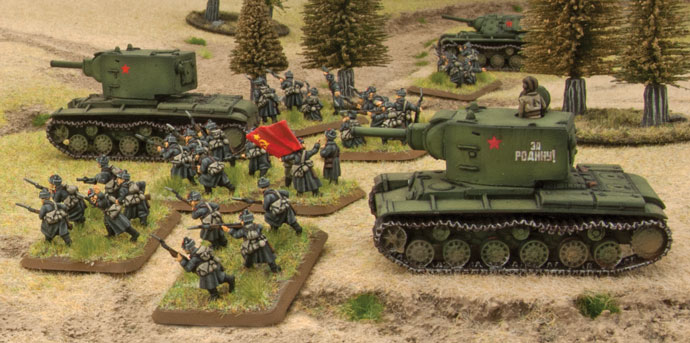 |
Similar encounters continued through June and
July 1941 with the Germans unable to defeat either the T-34 or KV heavy
tanks with their tanks alone. Often they would use their superior
communications and vehicle reliability to bypass the Soviet armoured
concentrations.
However, the new Soviet tanks has their
drawbacks. These early production models suffered from limited
reliability and poor maintenance due to a lack of spare parts and
training among the units’ mechanics. In fact, the Soviet mechanised
corps lost more T-34 and KV tanks to during their movement to the battle
than in the actual fighting.
German Solutions
The
Germans soon began to come up with ways of disabling and destroying
these new threats. Initially tank crews began to target the running
gear, drive sprockets, and tracks to immobilise these beasts, but often
the Soviet crew would keep firing while they still had ammunition.
Panzer
III commander, Oberfeldwebel Herman Bix, made a name for himself by
silencing a KV-1 tank by putting a round through its barrel at extremely
close range. However, this sort of action took extreme nerve and an
excellent gunner.
Unit commanders also called up pioneers to
knock out the vehicles with anti-tank mines and explosives, targeting
the engine deck, while the Panzer gave supporting fire to distract the
Soviet crew.
A third option was to call up either 8.8cm FlaK36
anti-aircraft guns from the Luftwaffe or the s10cm K18 guns of the
artillery to knock out the Soviet tanks with direct fire. These proved
very successful in knocking out both the T-34 and KV tanks.
|
KV-2
Crew: 6 men. Weight: 52 tons. Main Armament: 1x 152.4mm obr 1938/40 tank howitzer. Secondary Armament: 3x 7.62mm DT machine-guns. Ammunition: 36x 152.4mm rounds, up to 3087x 7.62mm rounds. Hull Armour: Front: 75mm, Sides: 75mm, Rear: 60-75mm, Top: 30-40mm, Bottom: 30-40mm. Turret Armour: Front: 110mm, Sides: 75mm, Rear: 75mm, Top: 35mm. Engine: V-12 W-2-K Diesel, 600 hp at 2000 rpm. Length: 6800mm, Width: 3350mm, Height: 3250mm. Ground clearance: 450mm. Top Speed: 26 kph. Range: 250 km.
|
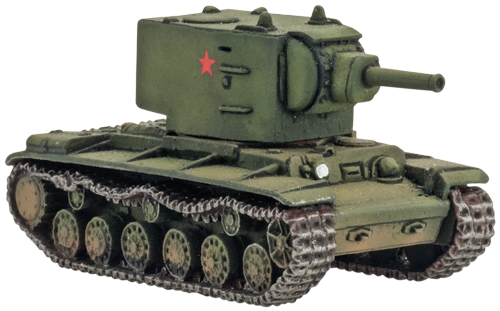 |
| The KV-2 in Flames Of War |
| |
|
|
Armour
|
|
|
| Name |
Mobility
|
Front
|
Side
|
Top
|
Equipment and Notes
|
Weapon
|
Range
|
ROF
|
Anti-tank
|
Firepower
|
|
KV-2
|
Slow Tank
|
8
|
7
|
2
|
Hull MG,
Turret-rear MG,
Limited vision, Unreliable. |
152mm obr 1938/40 howitzer
|
24"/60cm
|
1
|
10
|
1+
|
Bunker buster.
|
|
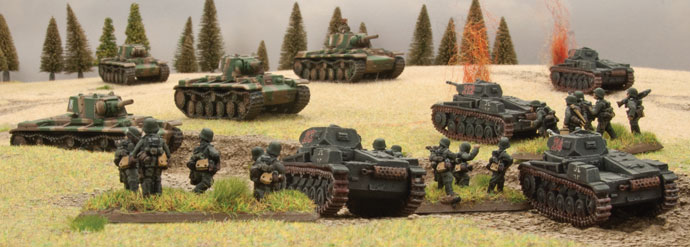
|
Influence On Future Designs
The introduction of the T-34 and KV tanks to the war influenced German tank design, while the Soviets looked to improve and develop both tanks further.
The first Soviet modifications to the designs was already underway. The next models of the both the T-34 and the KV-1 were fitted with the longer and more powerful 7.62mm F-34 gun (T-34 obr 1941 and KV-1 obr 1940), giving them better armour penetration and greater range. This was quickly followed by up-armouring the KV-1 further, first with bolt-on extra armour, then by uparmouring production models of the KV-1.
As the war went on, modifications to the T-34 saw improved turret design with twin hatches, the addition of a cupola to improve the commander’s vision (T-34 obr 1942), and eventually the up-gunning with an 85mm gun (T-34/85 obr 1943).
These modern Soviet tanks also influenced the design of German tanks, both in the form of up-armouring and upgunning of the Panzer III and Panzer IV tank, as well as influencing new designs.
The Tiger I E heavy tank owes its existence to those early encounters with T-34 and KV tanks. Though, a heavy tank design had been on the drawing board since 1937, encounters with the new Soviet tank brought a new impetus to the design process. No longer did the designers attempt to balance firepower with mobility and armour as had been done with the Panzer III and Panzer IV medium tanks. Instead, armour and firepower were prioritised, which led to a much heavier and slower tank. Nevertheless the design that would prove superior to the Soviet’s designs in firepower with its 8.8cm gun. Its front armour is was much more resilient than the T-34 and equal to that of the uparmoured KV-1 models. The Tiger I E first went into action in on 23 September 1942.
|
In Service
The new T-34 and KV tanks were issued to the mechanised corps, but
15,000 T-34 and KV tanks were required to fully equip all the corps’
tank divisions. Soviet industry in 1940 could not produce more that
5,500 of all tank types per year, and by the time of the German invasion
on 22 June 1941, only a portion of the divisions had received the new
tanks.
|
| T-34 and KV Tanks in Service, 22 June 1941. |
1st Mechanised Corps
8 T-34, 6 KV
|
2nd Mechanised Corps
46 T-34, 10 KV
|
3rd Mechanised Corps
109 T-34, 52 KV
|
4th Mechanised Corps
359 T-34, 99 KV
|
6th Mechanised Corps
238 T-34, 114 KV
|
7th Mechanised Corps
30 T-34, 30 KV
|
11th Mechanised Corps
28 T-34, 3 KV
|
8th Mechanised Corps
100 T-34, 71 KV |
15th Mechanised Corps
72 T-34, 64 KV
|
19th Mechanised Corps
2 T-34, 6 KV
|
|
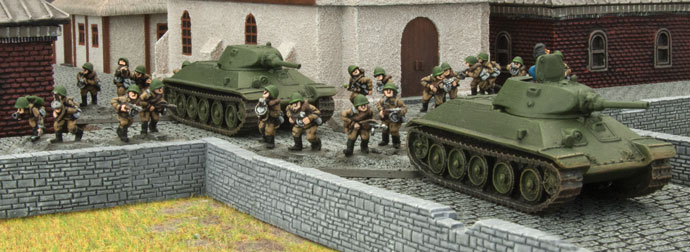 |
The German Panther tank was a direct response to the threat of the T-34 and KV tanks. At the insistence of General Heinz Guderian a special commission was set-up to access the T-34 medium tank. The things noted by the Germans as important aspects of the T-34 design were its sloping armour, which increased the effective thickness of the armour, its wide tracks, which reduced its ground pressure and improved its mobility, and it superior 76.2mm gun. Daimler-Benz and Maschinenfabrik Augsburg-Nürnberg AG (MAN) were asked to design a new 30 to 35-ton tank. The result was the Panther medium tank, which incorporated the sloped armour of the T-34, as well as its wide-tracks. It went further than the T-34 by being armed with the excellent 7.5cm KwK42 gun, probably one of the most effective tank guns of the war. However, all this took time and resulted in a tank, though superior to the T-34, which was also much more complicated and time consuming to manufacture and maintain than its Soviet rival. The Panther first saw action during the Battle of Kursk in July 1943.
While these new German tanks time to get to the front, modification to existing German designs were somewhat quicker to implement. Additional armour had already begun to make an appearance in newer Panzer III and Panzer IV model tanks during 1941. New guns and improved ammunitions also went some way to giving the German tanks a chance against the T-34, though KV still proved frighteningly difficult to deal with.
The introduction of the long L60 5cm gun to the Panzer III in 1942 improved the armour penetration of the Panzer III J tank. The addition of a high-explosive Anti-tank (HEAT) round to the short L24 7.5cm gun of the Panzer IV increase its firepower, but not its shorter range compared to the T-34’s gun.
During 1942, the Germans decided the life of the Panzer III as the main combat tank was drawing to a close and that the larger Panzer IV provided a better platform for upgrades. This eventually led to the fitting of a modified version of the 7.5cm PaK40 gun, the 7.5cm KwK40 gun, to the Panzer IV F2 medium tank, which gave it the same range as the T-34 and better armour penetration. Later models improved the Panzer IV tank’s armour, but to never to the extent of the T-34.
|
 |
The KV’s and T-34’s Impact On The Rest Of The War
The T-34 went on to become one of the most numerous tanks manufactured by any nation during the war, only rivalled by the American Sherman tank. The T-34 in its many forms and variants became the core of the Soviet armoured forces, taking part in every Soviet offensive between 1941 and 1945. Some would argue it was the tank that won the war.
The KV, on the other hand, did not have the same longevity during the war. However, its design was to influence its replacement, the IS (Iosef Stalin) line of heavy tanks. It’s main problem was its 76.2mm gun, which became less effective as the war went on. While still powerful enough to deal with Panzer III and Panzer IV tanks, it could do little against the newer German Tiger and Panther tanks.
Initial solutions included the KV-1s, which had less armour and better speed, opening the option to out flank the enemy, but it was still armed with the 76.2mm gun.
Another variant was the KV-85, which mounted the 85mm gun giving the tank greater penetration. But only small numbers were built as a new tank was about to hit the production line, the Iosef Stalin tank.
The Iosef Stalin tank took many of the key elements of the KV series such as it thick armour, suspension and basic hull design and combined them with a new cast turret, and better shaped and distributed armour. Initially, the turret mounted an 85mm gun as the IS-1 (or IS-85), but the intention was to mount either a 122mm or 100mm gun to it. In the end the 122mm D25T gun was decided on because of its superior high-explosive round and a short supply of the 100mm gun. The 122mm was still a formidable anti-tank weapon, but was slow to load due to its two-part ammunition and single loader.
|
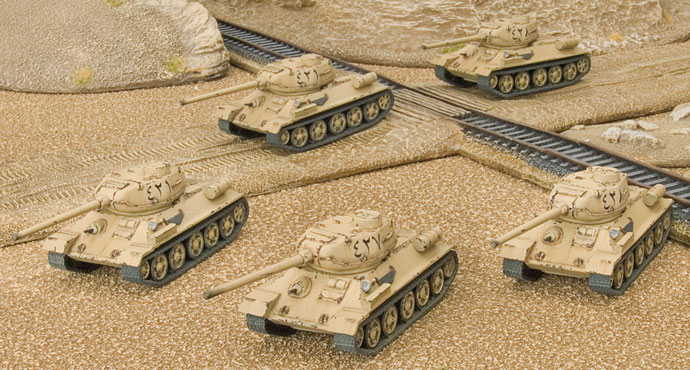 |
The T-34 after World War Two
The T-34/85 was such a successful design that its life stretched way beyond the end of World War II. It continued to be used throughout the Eastern Block and Third World, fighting in many and various conflicts around the globe.
The T-34/85 saw service in conflicts all over the world between 1945 and the 1990s. It was used in Korea by the North Koreans and Chinese, in Vietnam by the North Vietnamese, during the Arab-Israeli wars by the Syrians and Egyptians, as well as various local wars in Africa and Asia. It saw action with the Soviets in Germany in 1953, and the putting down the Hungarian uprising in 1956, where it was also used by Hungarian forces. It was even used as late as the 1990s in Bosnia. Iraq had some in service during the first Gulf War in 1991 as airfield defence. The Soviets and Finns retired their T-34 tanks in the 1960s, while many nations, especially in Africa, still have them in service. It was also manufactured
by various Eastern Block nations such as Czechoslovakia and Poland for their own use and for export. Further development of the T-34 during 1945 to 1947 led to the T-44 and the T-54 tanks. The T-54/55 is still in service with many countries around the world.
~ Wayne.
|
Last Updated On Wednesday, October 15, 2014 by Blake at Battlefront
|
|